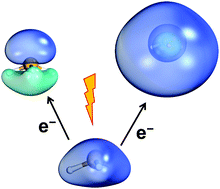Electronic structure of the ground and excited states of neutral and charged silicon hydrides, SiHx0/+/−, x = 1–4†
Abstract
The ground and excited electronic states of the titled species are investigated with multi-reference configuration interaction and diffuse basis sets. We found that in addition to the valence orbitals, the inclusion of the 4s, 4p, and especially 3d orbitals (although with minimal population) of silicon in the active space of the reference complete active space self-consistent field wavefunction are necessary for the proper convergence of the calculations. We also demonstrate that the aug-cc-pVTZ basis set provides quite accurate results compared to both larger basis sets and basis set limit results at a lower computational cost. The excited states involve excitations within the 3s and 3p orbitals of silicon (especially for the mono- and di-hydrides), followed by excitations from the Si–H bonding orbitals to either silicon valence or Rydberg (4s, 4p) orbitals. The number of electronic states per energy unit decrease as we add hydrogen atoms, and the first excited state of SiH4 is at 9.0 eV and leads to SiH3 + H. All species have stable ground state structures with all hydrogen atoms bound to silicon, except for SiH4+ and SiH4−. The former dissociates to SiH2+ + H2, while the latter loses an electron or can dissociate forming H2 as well.



 Please wait while we load your content...
Please wait while we load your content...